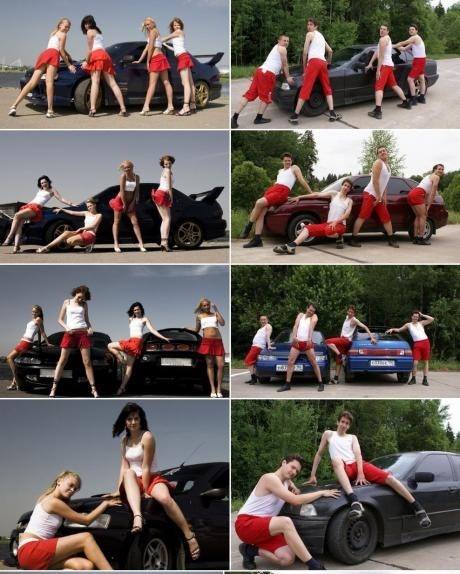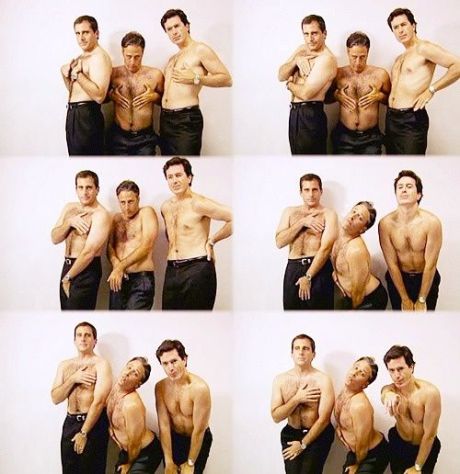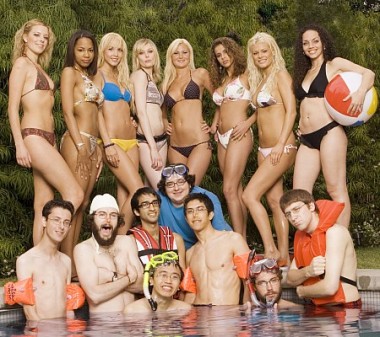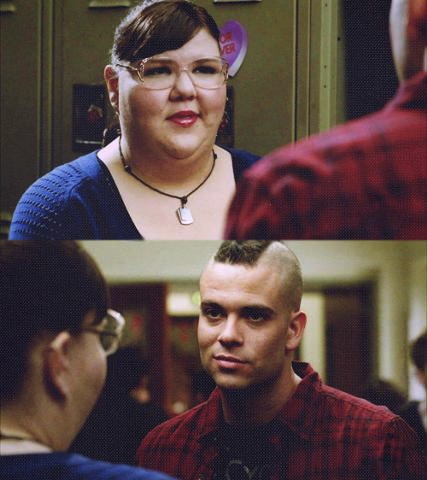Why ‘the shoe on the other foot’ doesn’t work.
March 30, 2014
I have grappled with the issue of pitting and comparing the actions and/or adversities of one gender by using the other to illustrate, for a long time – but it simply does not sit right with me.
It is like comparing apples with oranges.
For the most part, I believe the intention is generally a positive one (which is a refreshing step toward good), but when perceptions and customs related to gender are so profoundly entrenched, it falls short of accurately addressing the deep-seeded issues of gender disparity.
Exhibit A:
This is a familiar visual representation that now seems to be common practice in highlighting gender-label ridiculousness – namely, a female’s.
There are two issues I have with this sort of juxtaposition:
1. Females have always been represented in this way – used as (sexual) ornaments. Males never have. So when we look at the females in the images, we see ‘normal’ and when we scan across to the males in similar poses, we see humour.
Steve Carell, Jon Stewart and Stephen Colbert recently did a photo shoot, emphasising the ludicrous poses females are encouraged to do:
Its intentions are admirable but – it’s not the same. It’s just funny.
That humour can (ultimately) also work negatively for the females they’re trying to help, by making them look stupid for participating in their own exploitation; for posing that way in the first place.
I recently saw a snippet of reality TV the other day – one that does renovations on houses. There was a moment where all the contestants had an impromptu dance-off, which lead to the inevitable circle where they strut their stuff in the middle. One of the women chose to be semi-provocative by doing some fetching grinding moves against her partner.
Next was a male. He also did a bit of a provocative dance. It was funny. Everyone laughed.
2. The biggest issue, however, is vulnerability.
When a female is posing sexually, she is vulnerable – her breasts may be practically exposed; she may be bending over something with a short skirt; she may be wearing impossible-to-walk-in-heels (not easy to escape anyone in high heels btw) – you follow my drift.
The males in these representations, however, are not vulnerable.
Their only place of vulnerability is their penis and that is (as always in this current paradigm) *fully* covered.
Everywhere; every time.
How ironic that we seem to find comfort in the male gender – dipped head high in privilege – outlining the woes of the ‘lesser’ gender. Double irony? In most cases it’s statistically males pushing females to pose this way in the first place.
OK, let’s turn the tables; in format as well as gender reversal.
Let’s look at how men are represented and doing the switch.
Exhibit B:
The image above is from the show, Beauty and the Geek. Never before have I witnessed such a blatantly sexist prime-time show; super-gluing more gender stereotypes to an already fragile equation.
Female = sexy, hot and DUMB;
Male = be who you want to be, you can still get a ‘hot’ female.
Can you imagine a show – heck, a REALITY – where we see females who are daggy/geeky/nerds of various body shapes, together with ‘hot’ males?
I can – but know it’s a concept that is (for the most part) a flash in the pan.
I remember through ads that Glee had a moment where an overweight girl was coupled with the hot football player.
I wonder how many people were genuinely comfortable watching that visual?
I say visual because that’s all ANY of this is based on.
It’s irrelevant whether personalities gel or if people have a profound connection, because ultimately that’s not the message that wants to get taught; there’s no money to be made, if females are secure within themselves, after all.
I intensely wish for a more equal and balanced playing field for females and the bottom line is that females are more than just being the packaging for males’ sexual fantasies.
Question #199: Isn’t this world ready – YET – to unlock the wonderful array of possibilities – just by getting past that horrifically limiting idea of females?
I’ll leave you to think.
My next post is my 200th Question.
Bring your thinking caps along.
Deep Breath.
x





Loud Cheering!! spot on.
I have seen all those reversed ads and It makes me cringe… it looks silly… and I don’t think anyone would take it seriously. they just laugh.
I also agree with the beauty and the geek. I have never watched it, but have seen the ads etc and cannot believe the blatant gender stereotyping for both men and women!
I struggle to believe that many women are not jumping up and down in anger at how they are constantly presented and cannot believe that even fewer men feel insulted at the way they are portrayed.. take the new snickers ad for example.
Have we been conned so overwhelmingly that we are now blind to it?? I some times feel that we are in a version of the matrix, and some of us are slowly awaking to the realities to be shocked at how terrible it really is, whilst others are still in the matrix with no idea that are are blinded.
once again you have presented an intelligent and thoughtful piece of truth for us all to ponder. Well done.
Thank youu, Verina!!
Yes, this current state of things and the way we are navigating through it, is terribly disheartening.
It’s the privileged silent that are the problem. Until they awake, we stay in this worsening spot.
Thanks again for your comment.
😀 xx
We are brainwashed to see women in this way as normal (as you say). Women in film and television also have to act a certain way in order to appear normal. They are taught to move their faces as little as possible in shots; when vision is played to them of women moving their eyebrows, gesticulating, moving their bodies etc it tends to look comic, and not right for most TV drama. Men of course are not called upon to minimise movement and expression in the way that women are. Same goes for the old Hollywood movies – woman literally moved as little as possible. The position of women in simple shots was deliberately staged – lighting and filters had to catch that passive-expressive eye watering look that is the substitute for facial expression and movement. And of course filters are heavily used in Australian TV on women.
I was quite struck by the impact when I first saw men posed in typical feminine photos, but I do recall thinking that their clothes did not sexualise them. In the pics above their shorts are long, their clothes are loose and of course men can go around shirtless without comment. They have become comic and, as you say, they are not vulnerable. And we are not surprised.
Yes! It’s such a snore, isn’t it?
Lovely to hear from you.
🙂 x
I’m kinda puzzled by your reaction. Of course it looks silly- that’s the point. The point is that the kinds of photos and shots that (generally men) demand out of women are silly and should not be commonplace. It illustrates the fact that woman-hating is so implicit in everything visual around us that we don’t even see it unless it’s pointed out.
My reaction is the way it is because humour is *not* the point. Noone laughs when they see the image of women this way because its sexual and on tap. So this type of juxtaposition, actually completely *misses* the point.
Females are being objectified and ultimately abused in some way or another – too many times violently. These magazines are ‘passive aggressive’. It’s bullying and it’s just the start.
We need men to understand why we need to stop seeing females like this – it’s wrong and dangerous for us. It’s toxic and humour just doesn’t cut it.
There needs to be a major shift in perspective by both males and females on this.
We need more done.
Thanks for your comment. I appreciate the discourse.
Of course no one laughs when they see women that way, but when they see men doing it, it’s ridiculous. That’s the whole point. It tells you that it’s ridiculous.
Yes. I understood your point from your last comment. I mustn’t have expressed myself correctly.
I see that demonstrating the ridiculousness of it all, is their purpose and I think it’s a step in the right direction (as I said in my post).
BUT what I’m saying is that we need *more* because it’s more than just ridiculous – it’s the starting point of something more sinister and this is the early inception.
We need more than humour, is basically my point.
Well, I don’t really see what else we can do, apart from attacking the premises of the opposition’s arguments. Capitalist thugs, like all thugs, only respond to force, and we don’t really have a movement large enough to threaten them.
Hear. Hear.
That’s my dream.
😀
We’re in agreement on that. I still think showing how ridiculous it is can be a good tool as well. But it’s got to be backed with sound analysis. Right now, it doesn’t seem to be. (in fact, the most well-known site for analyzing female v male poses is admined by a trans person)
And the irony deepens.
Unfortunately, I think it’s just starting… :I
The darkest moment before the dawn?
Too optimistic?
IMO gender atheism (or even gender agnosticism) is a long way away from even getting off the ground. I think we have a few more darker moments left.
:*(